Clay soil can be a gardener’s worst nightmare. Thick, dense, and poorly draining clay soil will usually hold water too well and can result in soggy roots. Amending clay soil with organic matter can improve soil quality somewhat, but your soil will still remain heavy in clay, which can limit the types of plants you can grow.
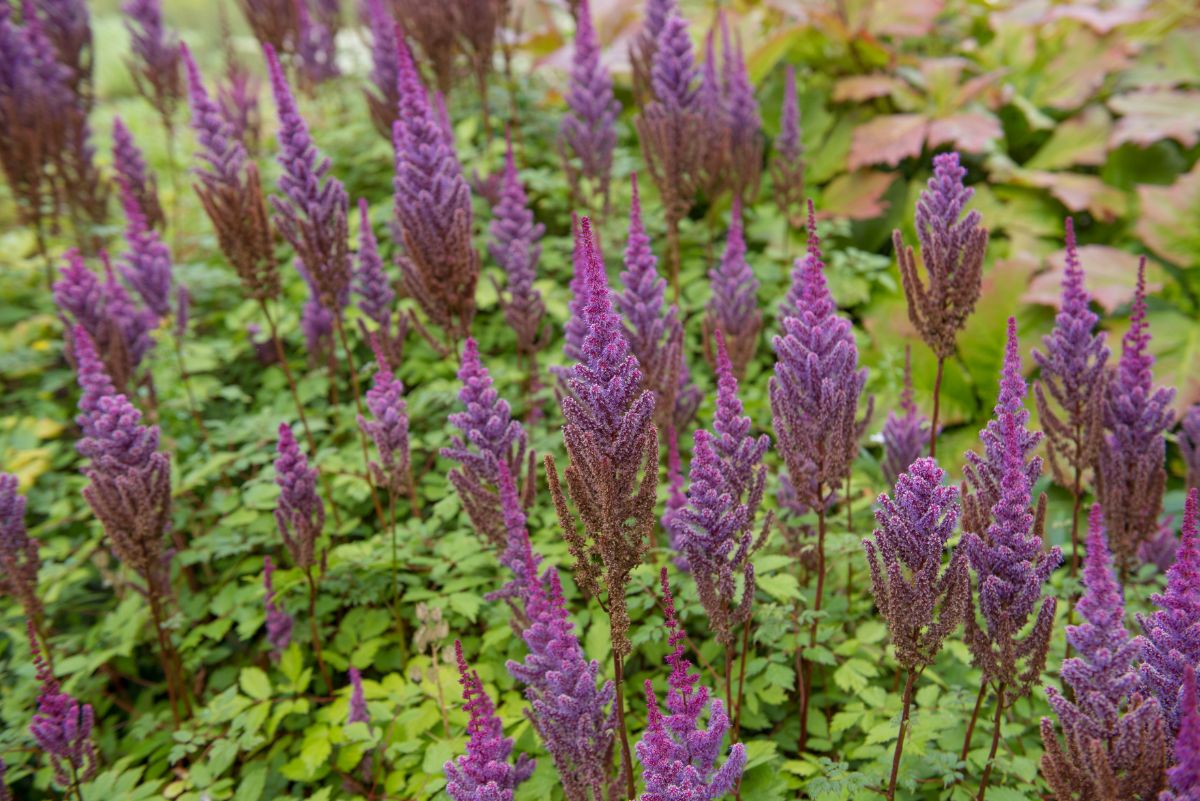
But fear not, because there are a ton of brilliant flowers that can thrive in clay conditions! Growing plants that are tolerant of clay can simplify your gardening tasks and set you up for a successful flower garden. In the list below, you’ll find some of the top flowers to keep in clay soil.
Jump to:
- 21 best flowers to grow in clay soil
- 1. Bee balm (Monarda spp.)
- 2. Astilbe (Astilbe chinensis)
- 3. Bearded iris (Iris × germanica)
- 4. Coneflower (Echinaceaspp.)
- 5. Black-eyed Susan (Rudbeckia hirta)
- 6. Liatris (Liatris pycnostachya)
- 7. Joe Pye weed (Eutrochium purpureum)
- 8. Indian pink (Spigelia marilandica)
- 9. Butterfly bush (Buddleja spp.)
- 10. Hosta (Hosta spp.)
- 11. Aster (Aster spp.)
- 12. Phlox (Phlox paniculata)
- 13. Coral bells (Heuchera sanguinea)
- 14. Hepatica (Hepatica spp.)
- 15. Goat’s beard (Aruncus dioicus)
- 16. Daylily (Hemerocallis spp.)
- 17. Sedum (Sedum spp.)
- 18. Helenium (Helenium autumnale)
- 19. Viburnum (Viburnum spp.)
- 20. Cardinal flower (Lobelia cardinalis)
- 21. Goldenrod (Solidago canadensis)
- Summary
21 best flowers to grow in clay soil
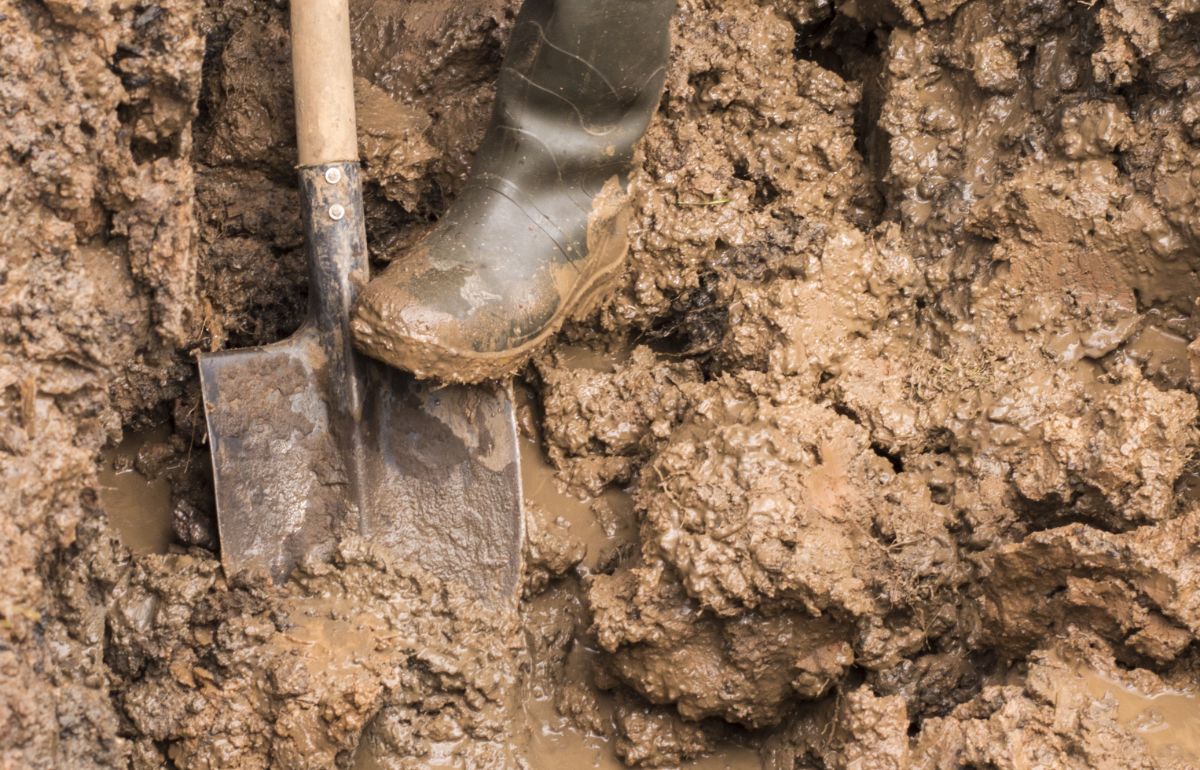
Regardless of the size of your garden, you’ll find the perfect low-maintenance flowers for you in the list below. We’ve included plants of different heights, so you can stack them together in a colorful planting design. Many of these flowers work well as accent specimens, and they’re pollinator favorites too!
1. Bee balm (Monarda spp.)

| Plant name: | Bee balm |
| Light requirements: | Full sun |
| Watering requirements: | Moderate |
| Growing zone: | Zones 3 to 9 |
| Special features: | Pollinator favorite; Edible |
Also known as wild bergamot, bee balm is a stately plant with a vivid spray of spiky flowers that look a bit like miniature fireworks when in full bloom. Flowers come in purple, red, and pink and look particularly attractive when planted in a large grouping. These fragrant flowers are also a preferred food source for bees, butterflies, and other pollinators.
Bee balm grows between 2 and 4’ tall, but you can create bushier plants by pinching off your bee balm from time to time. These plants are a member of the mint family, and they can spread rapidly via underground rhizomes, so you may need to prune them back to prevent them from becoming overgrown. Bee balm can tolerate a range of soils, including clay-heavy gardens.
2. Astilbe (Astilbe chinensis)
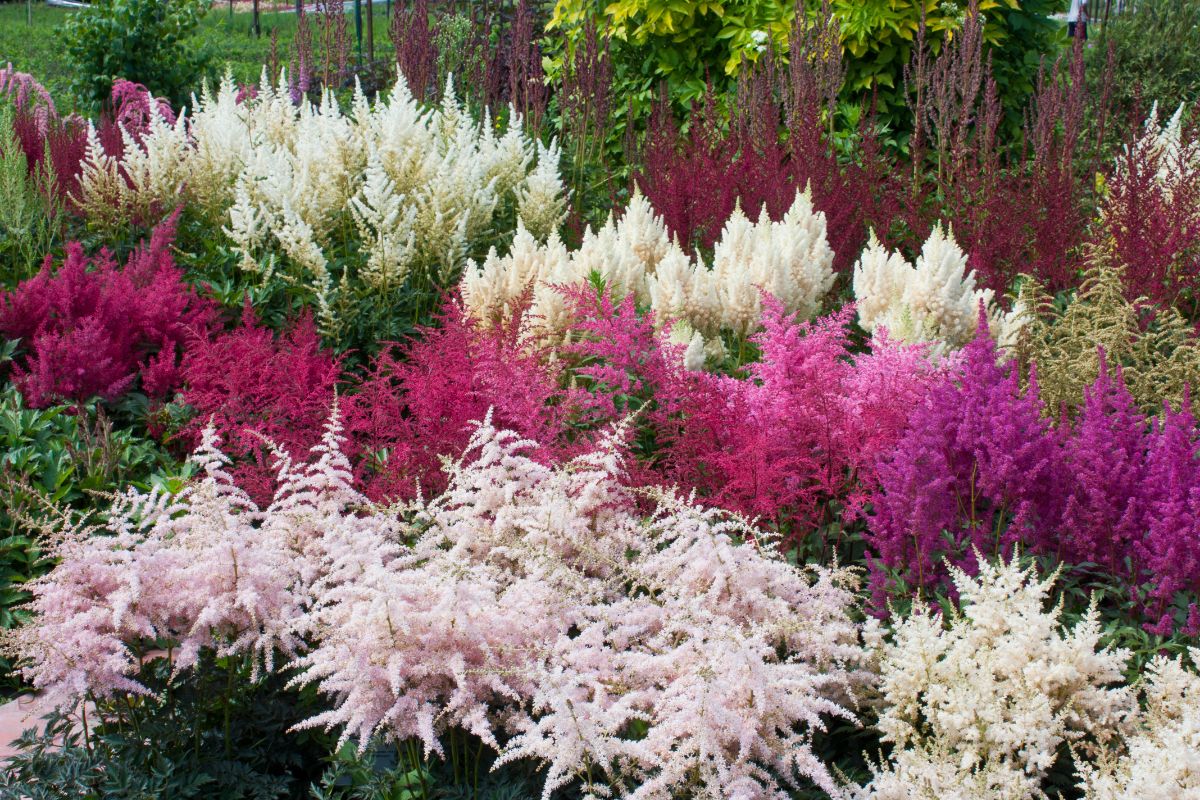
| Plant name: | Astilbe |
| Light requirements: | Full sun to part shade |
| Watering requirements: | Moderate |
| Growing zone: | Zones 4 to 9 |
| Special features: | Groundcover for weed suppression |
Astilbe is an easy-going plant with foamy, upright flowers in purple, white, pink, and red. Leaves are highly serrated and densely growing, providing tons of interesting texture to garden designs. Astilbe is often kept as a low-maintenance grown cover for weed suppression as it spreads readily and can block out lower-growing plants.
Astilbe can grow in full sun, but it prefers part shade, which makes it a good pick for lower-light gardens. As a vigorous grower, astilbe readily adapts to most garden spots, including clay-heavy areas. As it spreads, astilbe can be easily divided to create more plants.
3. Bearded iris (Iris × germanica)
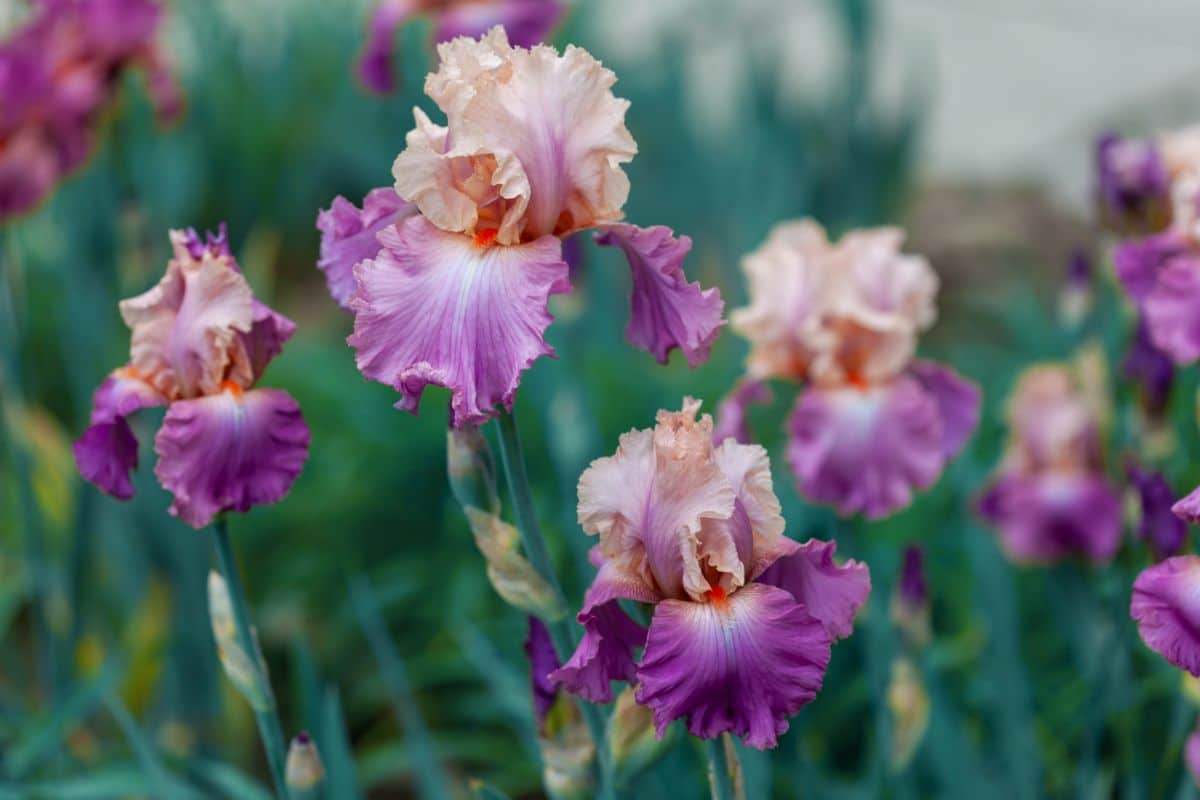
| Plant name: | Bearded iris |
| Light requirements: | Full sun |
| Watering requirements: | Moderate |
| Growing zone: | Zones 3 to 9 |
| Special features: | Divides easily |
Bearded irises come in almost any color you could want, so they’re a fine pick if you’re creating a color-coordinated garden design. While dwarf bearded irises are available, you can find taller iris varieties that reach 28 to 38” in height or even taller. These adaptable plants can grow in clay soil, but they need lots of sun to bloom.
Many bearded iris varieties are reblooming, which means you’ll get flowers in spring and again later in the season. Like many other perennials, bearded irises will spread vigorously, and they should be divided every 3 to 5 years to keep plants from getting overcrowded. Plant division is usually performed after blooms fade, in late summer to early fall.
4. Coneflower (Echinaceaspp.)
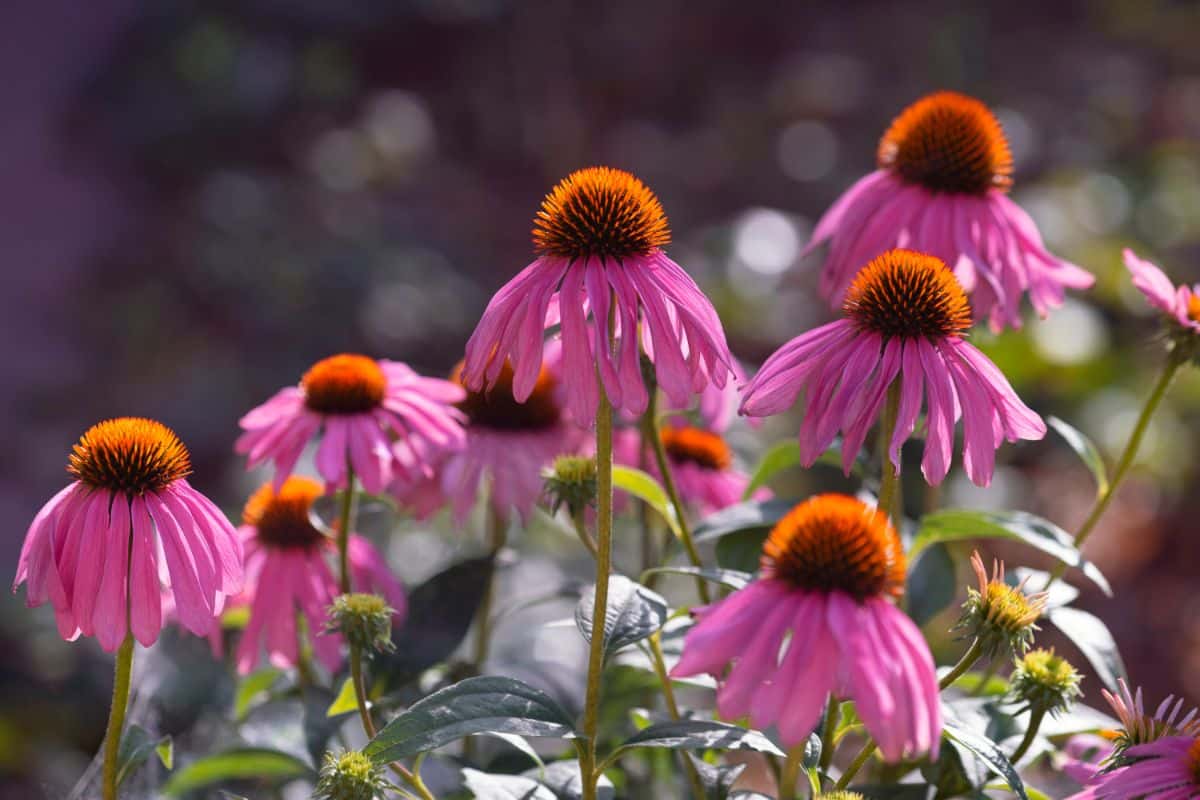
| Plant name: | Coneflower |
| Light requirements: | Full sun |
| Watering requirements: | Moderate to low |
| Growing zone: | Zones 3 to 9 |
| Special features: | Pollinator favorite; Drought resistant |
Also known as echinacea, coneflower is a popular medicinal plant and is often grown in pollinator gardens, where it attracts bees, butterflies, and other beneficial insects. This hardy flower can also tolerate different soil types, including clay, but it grows best in full sun. Coneflowers naturally grow in clumps, and planting a few of them together can create a more wild-looking and colorful design.
When mature, coneflowers reach between 2 and 5’ high, making them a good choice for mid-garden planting. Coneflowers bloom from mid-summer to fall, and planting them with earlier bloomers, like phlox and hepatica, will create season-long color. Leaving spent coneflower blooms in your garden in winter can provide seeds to birds and other wildlife.
5. Black-eyed Susan (Rudbeckia hirta)
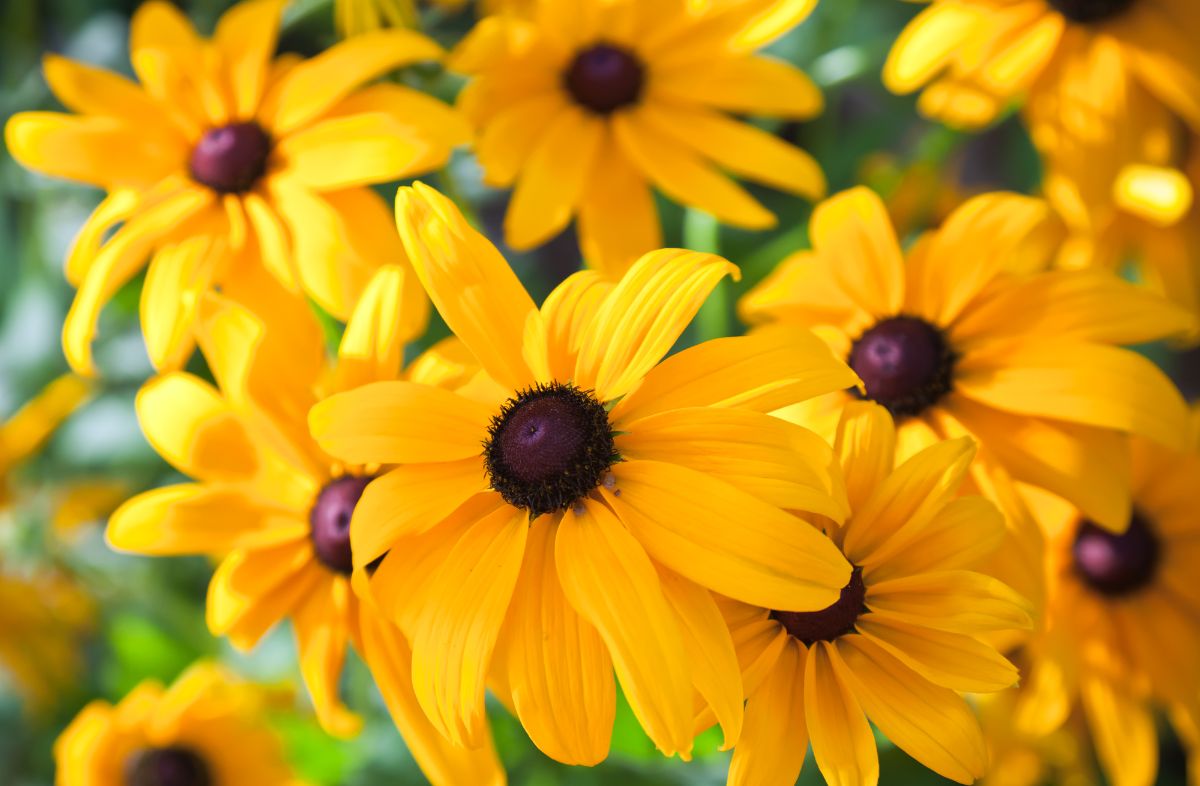
| Plant name: | Black-eyed Susan |
| Light requirements: | Full sun |
| Watering requirements: | Moderate to low |
| Growing zone: | Zones 3 to 10 |
| Special features: | Pollinator favorite |
Another low-maintenance plant, black-eyed Susan, looks a lot like coneflowers; however, they feature more warmly toned petals. Pairing coneflowers with black-eyed Susan in planting arrangements provides a burst of complementary colors, and these plants grow well together too! Black-eyed Susan blooms throughout the growing season, from June to September.
If you don’t want your flowers to self-sow, you may want to deadhead spent blooms, but leaving them in the garden will support wildlife. Like coneflowers, black-eyed Susan produces seeds that birds love to snack on. In addition to being wonderful pollinator plants, black-eyed Susans are well-suited for bouquet making!
6. Liatris (Liatris pycnostachya)
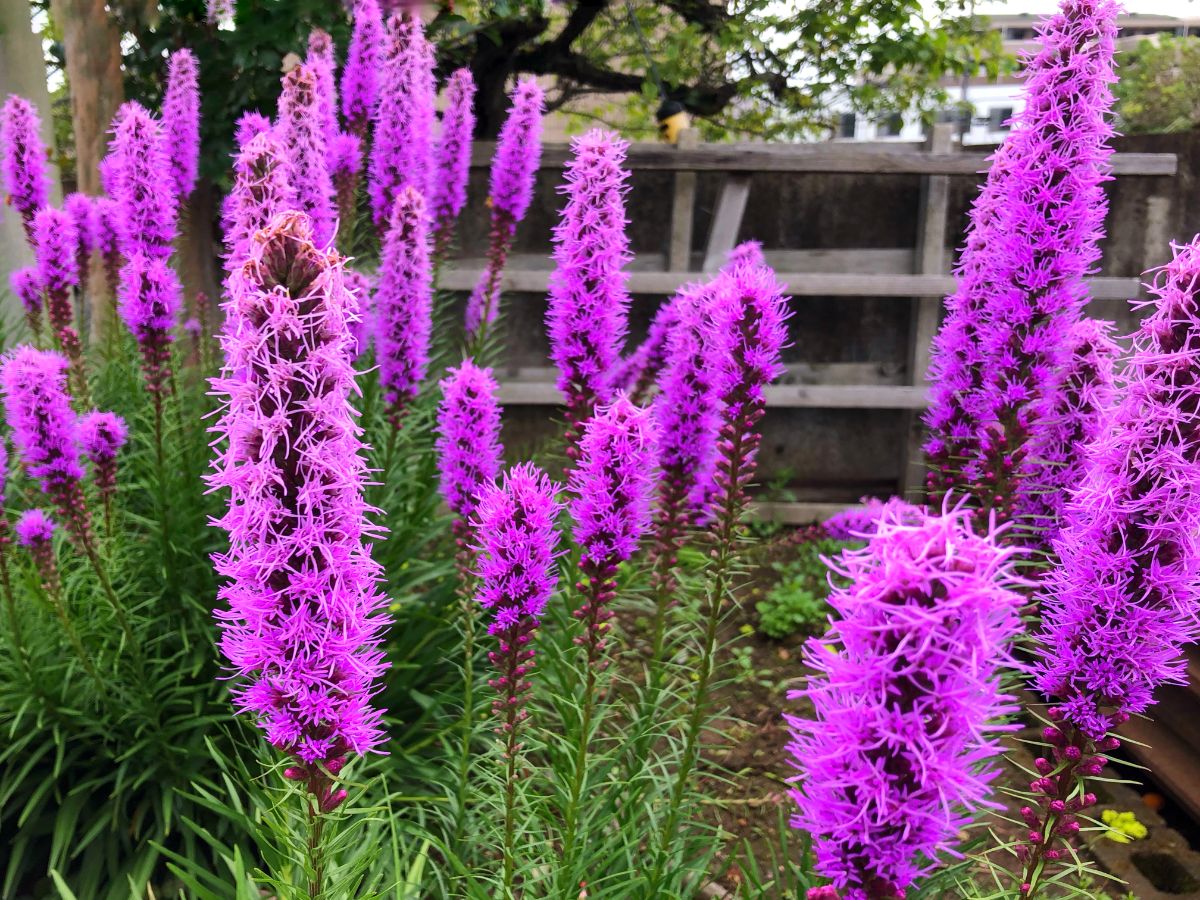
| Plant name: | Liatris |
| Light requirements: | Full sun |
| Watering requirements: | Moderate to low |
| Growing zone: | Zones 3 to 8 |
| Special features: | Pollinator favorite; Drought resistant |
Also known as blazing star or gayfeather, liatris flowers are uniquely shaped, with tall, slender spires in pink, purple, and white. Flowers form atop liatris’ grass-like foliage, which can add movement and texture to your garden beds. Full sun is required to keep liatris in bloom, but these plants are otherwise very tolerant and can be drought resistant once established.
Liatris is usually grown from corms that are planted in spring. New plants may need a bit of extra water during dry conditions, but once they become established, liatris are no-fuss plants and need minimal care. Try planting liatris in groups of 3 to 5 plants and interplant them with different types of flowers, like coneflowers, for a more varied display.
7. Joe Pye weed (Eutrochium purpureum)
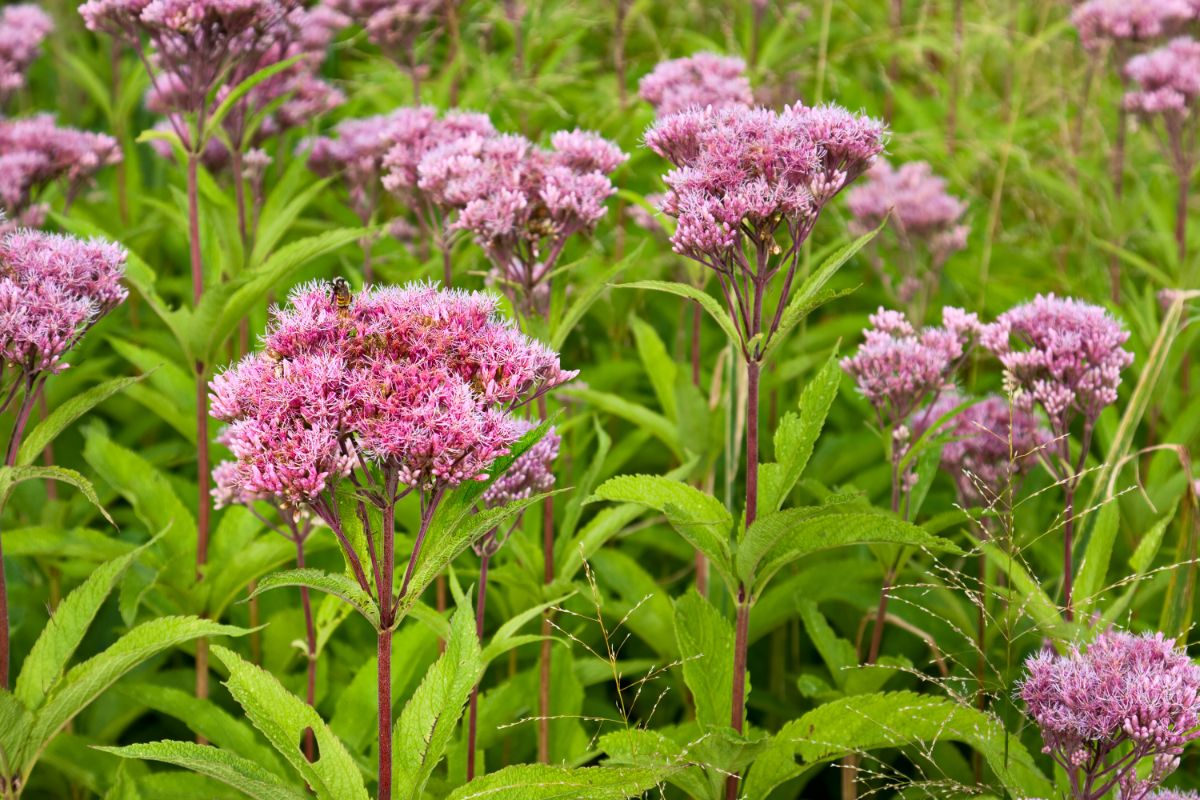
| Plant name: | Joe Pye weed |
| Light requirements: | Full sun to part shade |
| Watering requirements: | High |
| Growing zone: | Zones 4 to 8 |
| Special features: | Pollinator favorite |
Joe Pye weed is native to the United States and Canada, where it naturally grows in moist areas. In the garden, this durable plant can tolerate shade and moist soil. In fact, Joe Pye weed will grow best with mulch, since mulch will shield the soil line and keep it from drying out too quickly.
A rather large plant, the Joe Pye weed reaches 4 to 6’ high, and it should be planted singly as a specimen plant or located toward the rear of your garden beds to keep it from blocking the sun. Blooming from mid-summer to fall, Joe Pye weed blossoms into pink and purple flowers that look a bit like milkweed. Blooms are highly fragranced and will attract pollinators to your space too!
8. Indian pink (Spigelia marilandica)
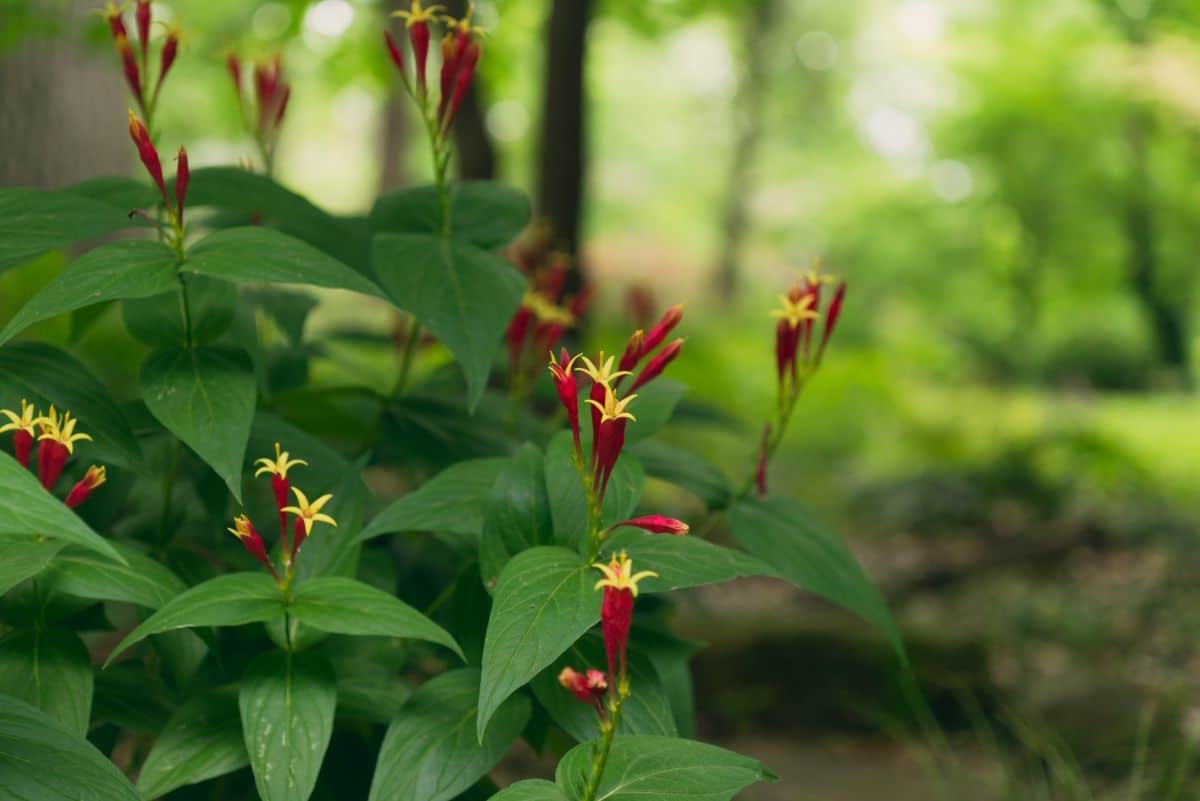
| Plant name: | Indian pink |
| Light requirements: | Sun to shade |
| Watering requirements: | Moderate |
| Growing zone: | Zones 5b to 9 |
| Special features: | Pollinator favorite |
Indian pink has trumpet-shaped flowers with bright red exteriors surrounding a yellow accented interior. A perfect plant to include in hummingbird gardens, butterflies also flock to Indian pink blooms when they emerge in late spring to early summer. Mature plants grow to about 18” high and look best when planted in groups of 3 to 5 (or more!)
These easy-to-grow plants prefer shadier locations, making them ideal choices for sowing under deciduous trees or in other low-light areas. Native to wooded spots, Indian pinks are impressive little plants, but they aren’t as cold-hardy as some of the other species on this list. In fact, they only grow as perennials down to zones 5b to 6.
9. Butterfly bush (Buddleja spp.)

| Plant name: | Butterfly bush |
| Light requirements: | Full sun |
| Watering requirements: | Moderate |
| Growing zone: | Zones 5 to 9 |
| Special features: | Pollinator favorite; Privacy shrub |
Butterfly bushes are statement plants that are commonly kept in pollinator gardens, where they provide lots of nectar to hummingbirds, butterflies, and more. Growing up to 15’ tall, butterfly bushes are perfect background plants, but they can be kept much smaller with frequent pruning. Pink, purple, or white blooms appear from mid-summer to fall and are highly aromatic.
To keep butterfly bushes looking their best, cut away dead growth from time to time. The best time to prune these plants is in spring, after new growth has begun to sprout. Avoid pruning butterfly bushes in fall, as this can make them more susceptible to winter damage.
10. Hosta (Hosta spp.)
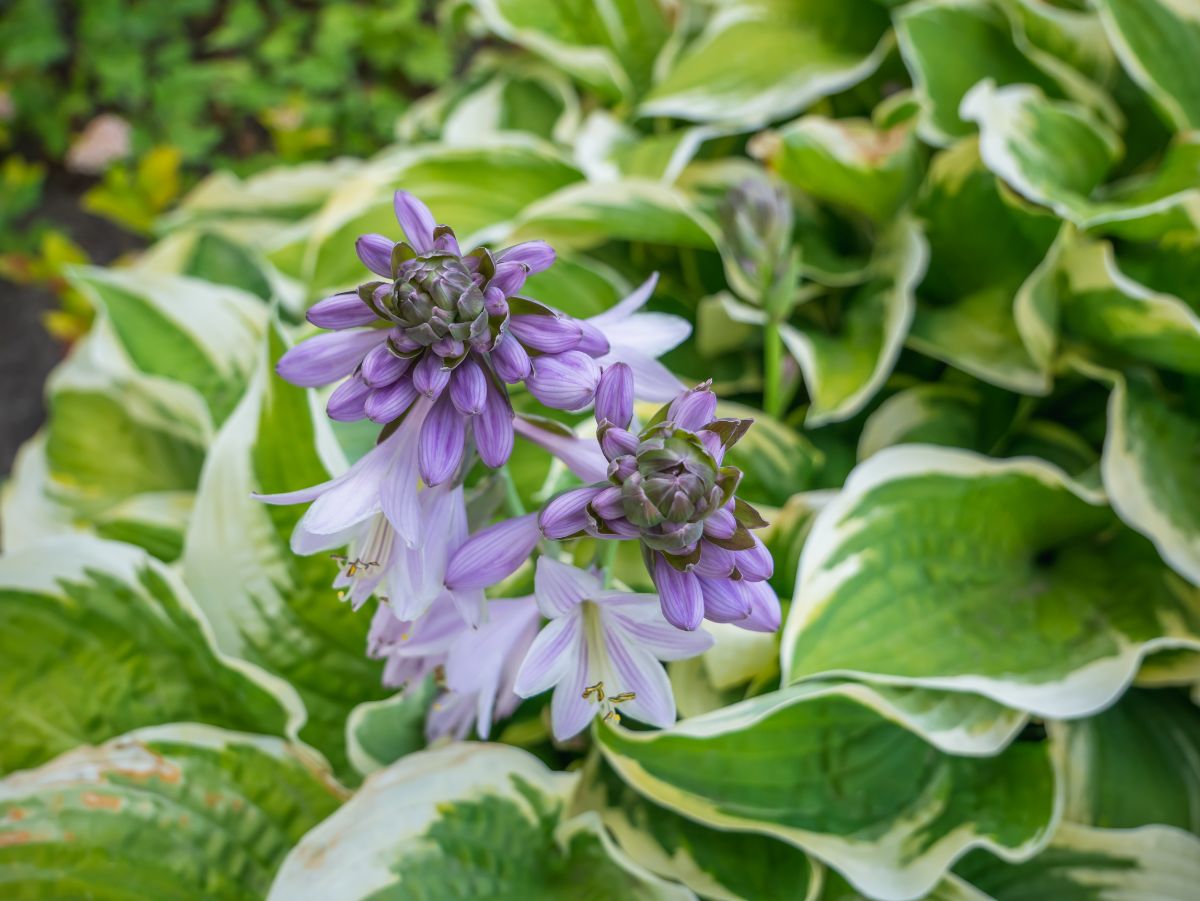
| Plant name: | Hosta |
| Light requirements: | Part shade |
| Watering requirements: | Moderate |
| Growing zone: | Zones 3 to 9 |
| Special features: | Edible; Colorful foliage |
A top choice for shady gardens, hostas are mostly kept for their highly variegated foliage, which makes a colorful accent to floral beds. Hostas also bloom tubular flowers atop tall stalks from May to September. Blooms are usually pastel in tone, with white, pink, and purple being common.
Hostas are well-known for being moisture lovers, so it’s no surprise they tolerate clay-heavy soils. Just keep in mind that hostas can be highly attractive to slugs and snails. To keep your plants safe, you may want to install “slug pubs” in your garden and companion plant strongly scented plants, like ginger, garlic, and mint, nearby.
11. Aster (Aster spp.)
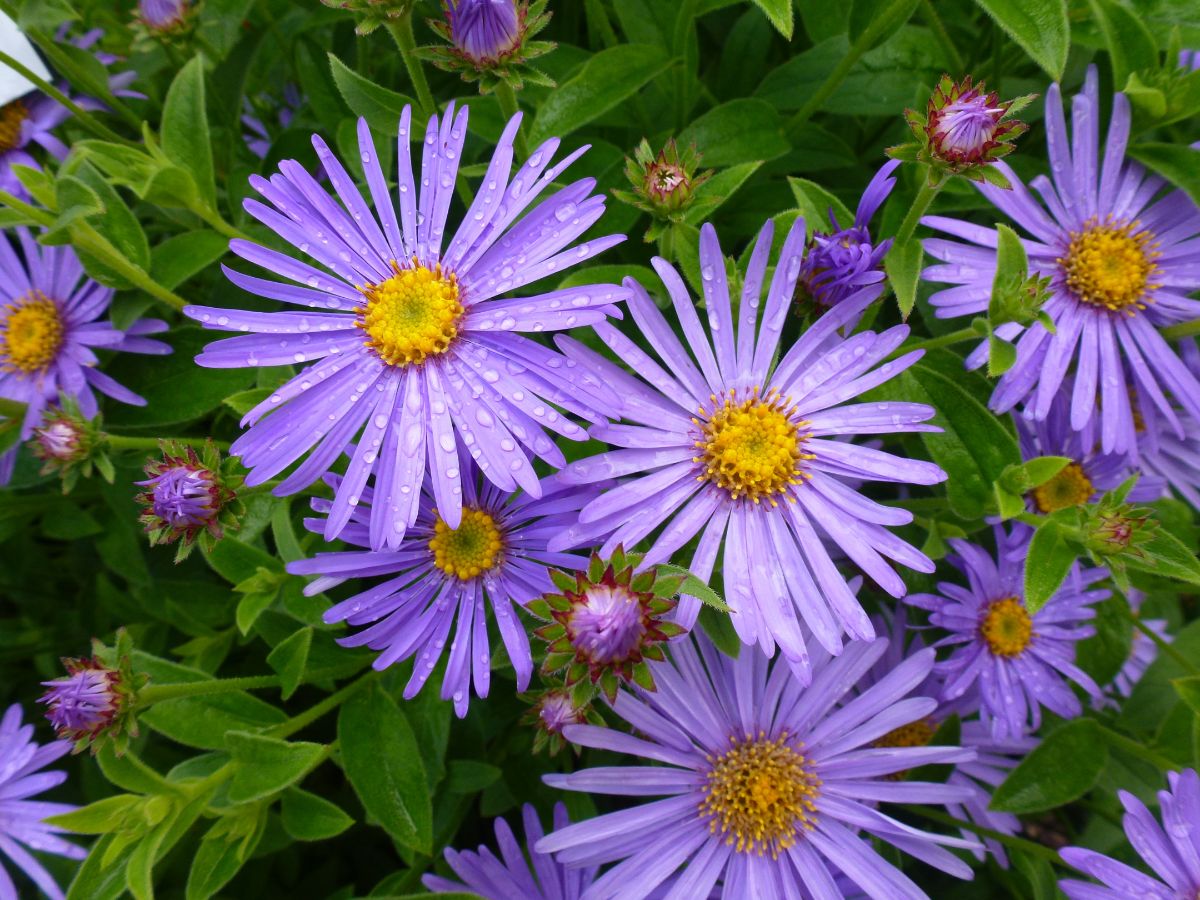
| Plant name: | Aster |
| Light requirements: | Full sun to part shade |
| Watering requirements: | Moderate |
| Growing zone: | Zones 3 to 8 |
| Special features: | Pollinator favorite; Late season bloomer |
Fall can be a bittersweet time for gardeners as they begin to put their beds away for the winter season ahead. But autumn always brings something to look forward to: asters! A fall favorite, asters bloom from late summer to early fall and produce daisy-like flowers in vivid pinks and purples.
Hardy to zone 3, asters are resilient plants that can handle cold and various soil types, including clay. Native to North America, there are many aster varieties to choose from, including short, 1’ tall specimens and 6’ tall asters too! An important food source for late-season pollinators, try pairing asters with goldenrod for lots of colors.
12. Phlox (Phlox paniculata)
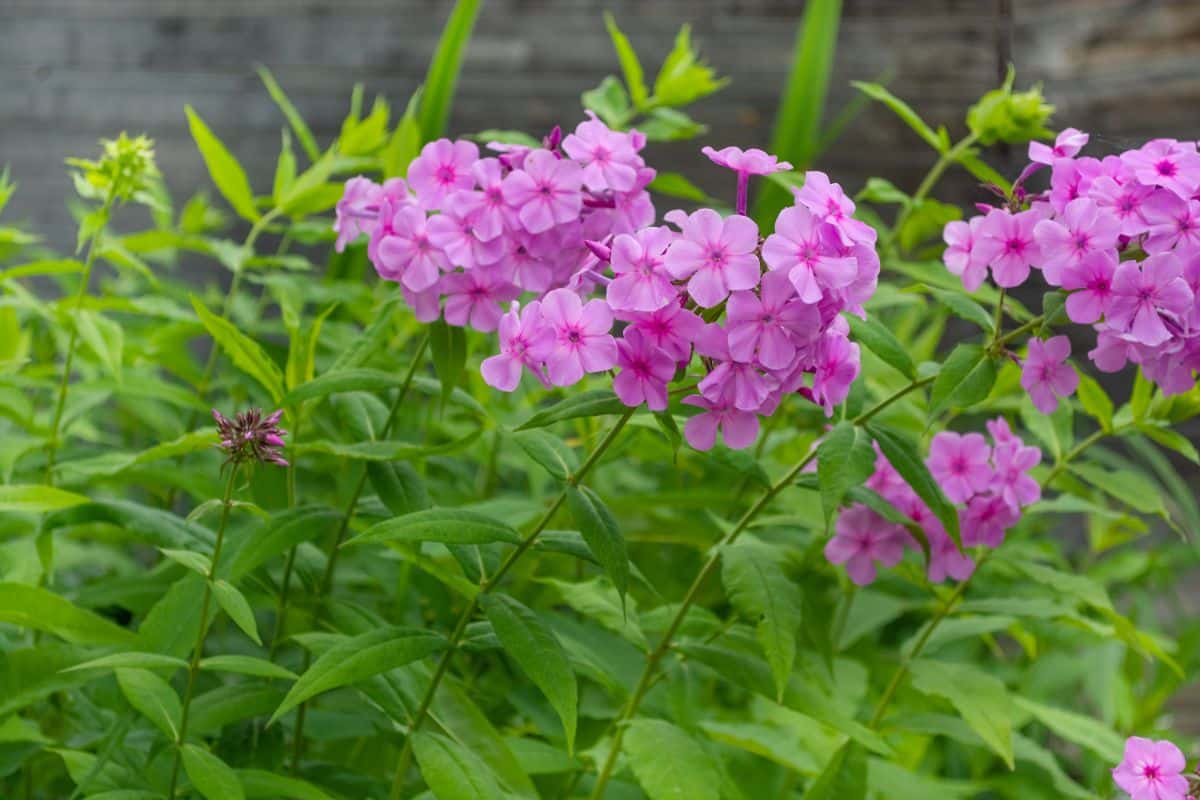
| Plant name: | Phlox |
| Light requirements: | Full sun to part shade |
| Watering requirements: | Moderate |
| Growing zone: | Zones 4 to 8 |
| Special features: | Pollinator favorite; Strong fragrance |
Tall phlox is another pollinator plant that blooms from mid-summer to fall. Not to be confused with creeping phlox, which is a spring-time favorite, tall phlox grows between 2 and 3’ tall and is a perfect choice for mid-garden plantings. These plants also produce a wide range of colorful blooms, although pink and white tend to be the easiest to find.
Tall phlox will grow in full sun to light shade and can tolerate clay soils. These plants are prone to powdery mildew, however, so be sure to only water them at the soil line. Following proper spacing guidelines and performing a good garden cleanup in autumn can also prevent mildew issues.
13. Coral bells (Heuchera sanguinea)
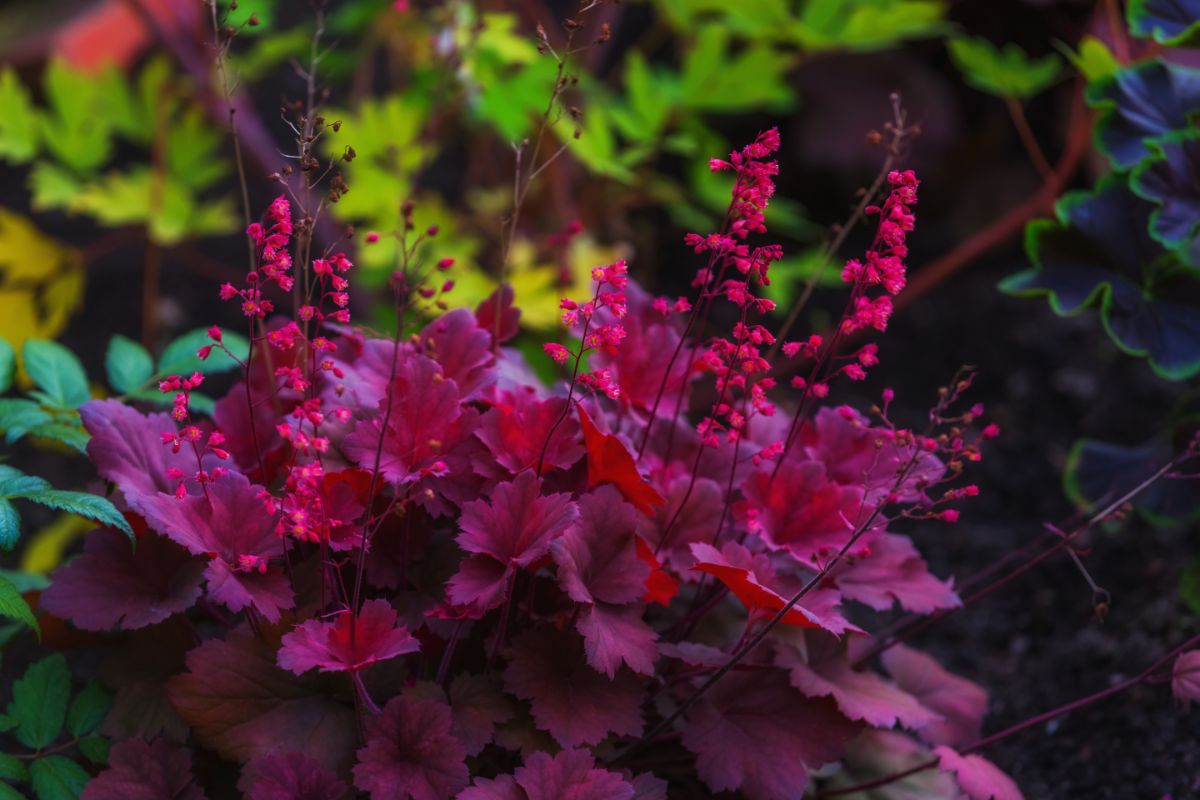
| Plant name: | Coral bells |
| Light requirements: | Part shade |
| Watering requirements: | Moderate |
| Growing zone: | Zones 4 to 9 |
| Special features: | Colorful foliage |
Also known as alum root, coral bells are usually kept for their colorful foliage, which livens up garden designs with chartreuse, gold, purple and other hues. These plants also bloom from late spring to early summer with their namesake bell-shaped flowers. Flowers appear along tall stalks in airy masses that let in the light and provide a delightful texture to garden designs.
Since they prefer moist soils, coral bells can handle clay, and they also grow best in shadier spots. Coral bells are usually unattractive to rabbits, which makes them a good plant to try if you have a lot of rabbits in your yard. Flowers will lure in pollinators, too, including butterflies!
14. Hepatica (Hepatica spp.)
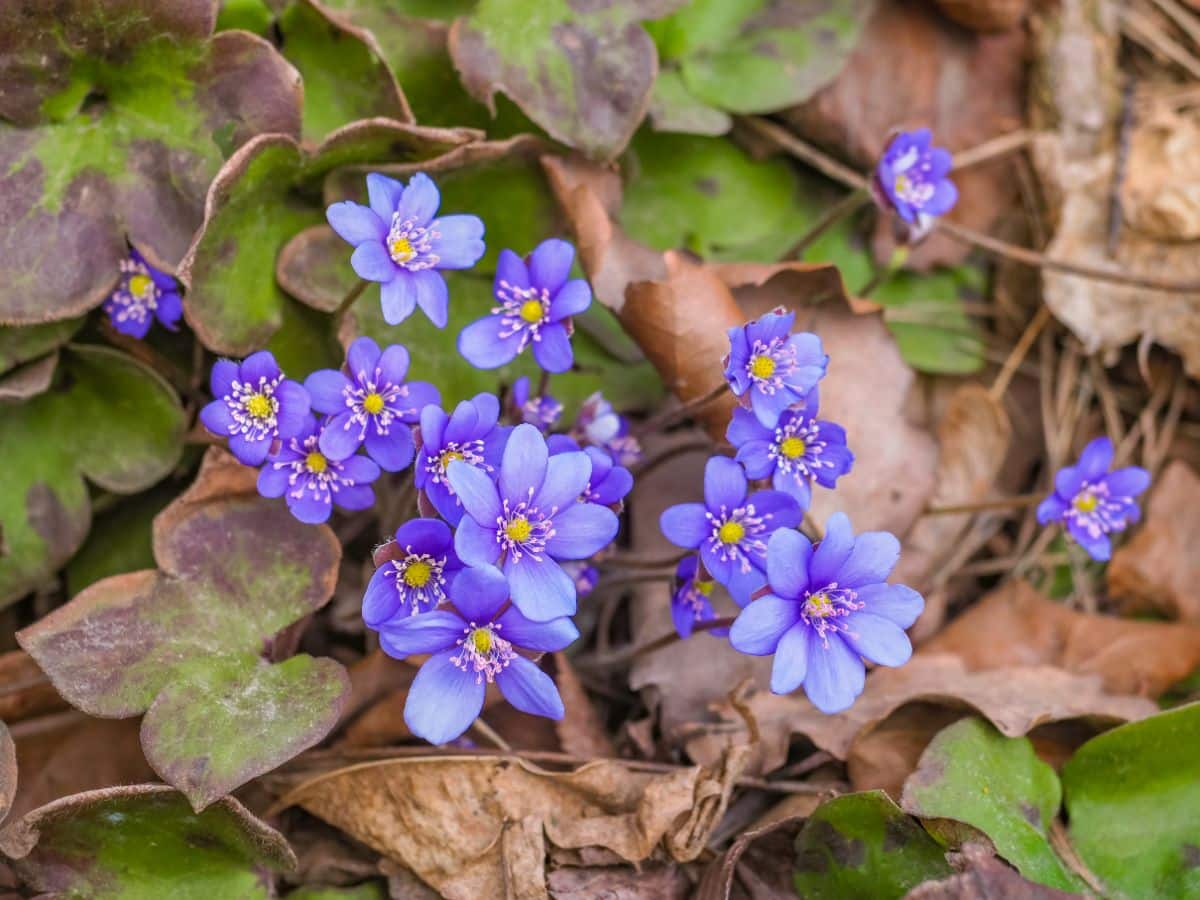
| Plant name: | Hepatica |
| Light requirements: | Shade |
| Watering requirements: | High |
| Growing zone: | Zones 4 to 8 |
| Special features: | Spring ephemeral; Early season bloomer |
Named for its lobe-shaped leaves that are said to resemble a liver, hepatica is a spring ephemeral that blooms from mid-April to mid-May. Sowing hepatica in clay soil is a good choice, since these plants prefer to grow in moist areas. Try planting a few hepatica beneath deciduous trees, and they’ll bloom and die back long before your trees leaf out in spring.
Hepatica is related to buttercups, and it is native to the Northern hemisphere. Hardy to zone 4, hepatica looks particularly alluring when interplanted with other native plants and spring ephemerals. Try sowing this plant with masterwort, pasqueflowers, or hellebores for dainty spring blooms.
15. Goat’s beard (Aruncus dioicus)
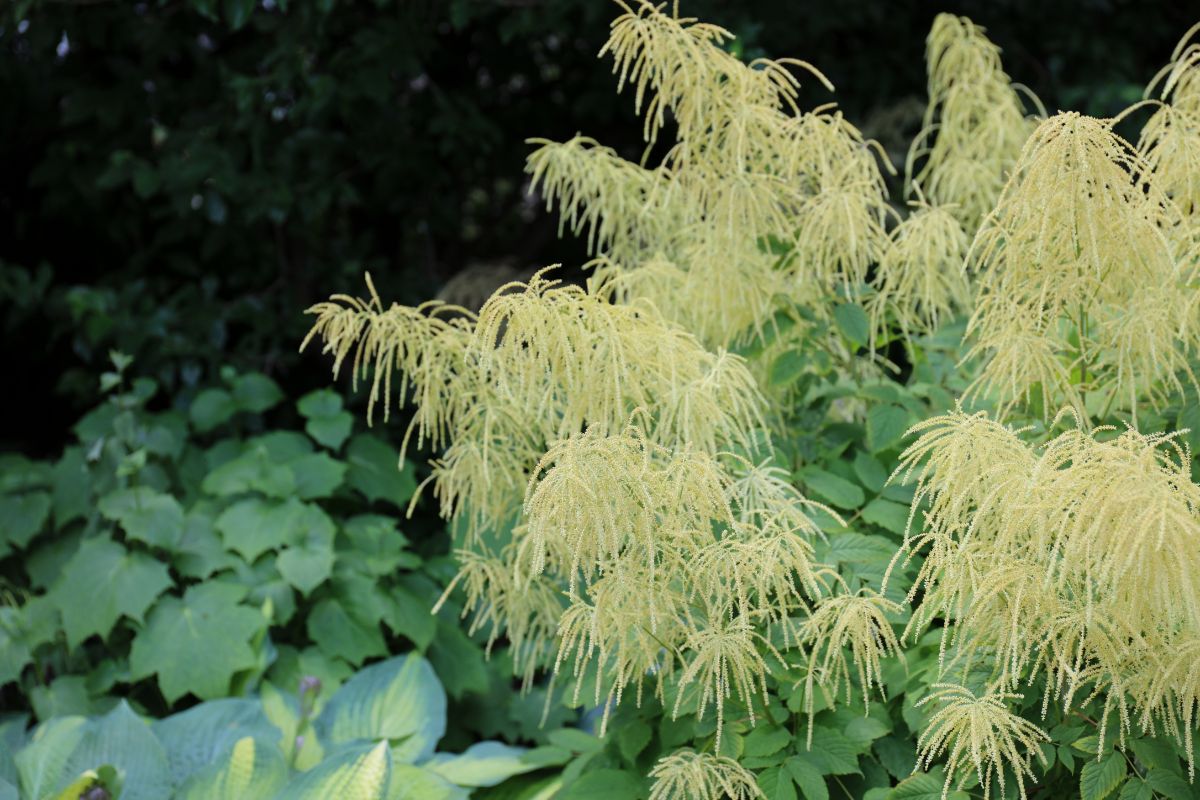
| Plant name: | Goat’s beard |
| Light requirements: | Full sun to part shade |
| Watering requirements: | High to moderate |
| Growing zone: | Zones 3 to 8 |
| Special features: | Privacy shrub |
Astilbe is sometimes known as “false goat’s beard” due to its resemblance to this plant; however, goat’s beard is the real deal. Goat’s beard grows a lot taller than astilbe and can reach about 6’ tall by 4’ wide. Like astilbe, goat’s beard has feathery or foamy flowers that catch the light beautifully, although goat’s beard blooms don’t come in as many colors.
A hardy, deciduous perennial, goat’s beard can be used as a backdrop plant or as a seasonal privacy screen. Naturally resistant to deer and rabbits, goat’s beard can grow in regions as cold as zone 3. A shade lover, goat’s beard prefers moist soil, and it can handle clay like a champ too!
16. Daylily (Hemerocallis spp.)
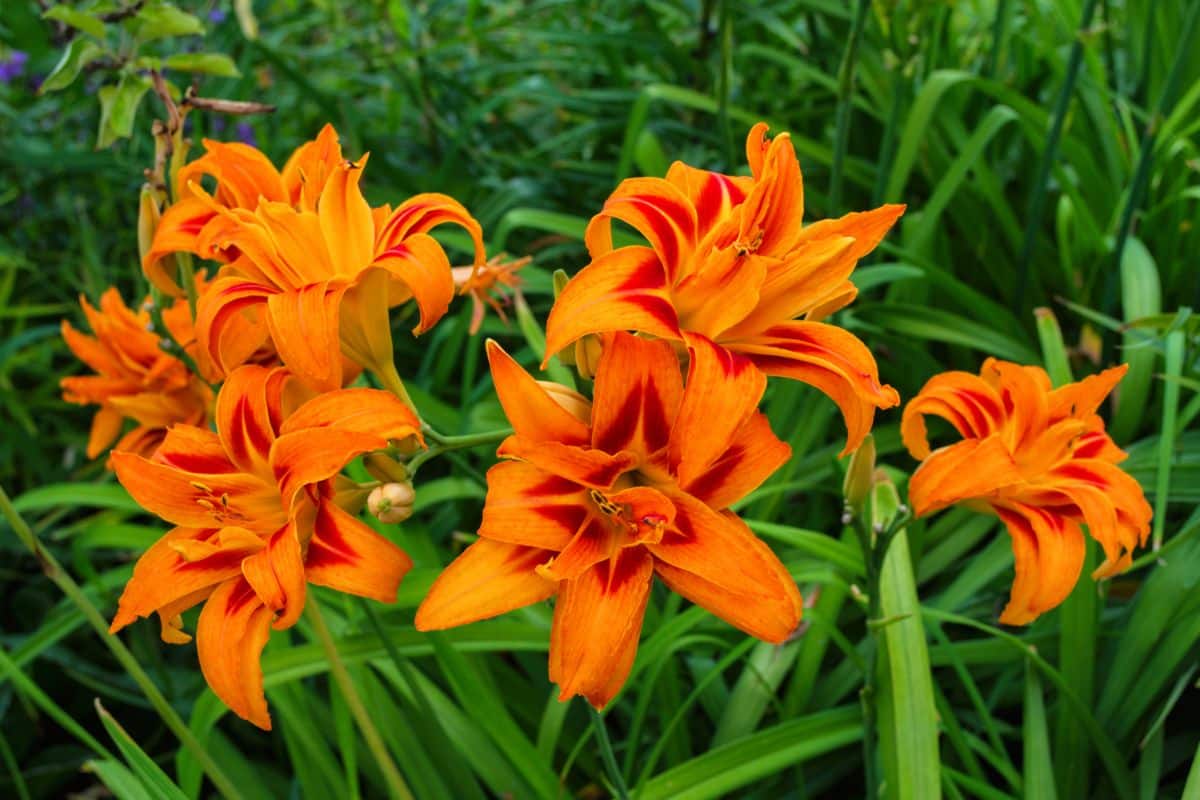
| Plant name: | Daylily |
| Light requirements: | Full sun to part shade |
| Watering requirements: | Moderate |
| Growing zone: | Zones 4 to 11 |
| Special features: | Edible |
Daylilies have a similar appearance to other lilies, but these plants aren’t true lilies. Native to Asia, daylilies have become naturalized in many areas of Europe and the Americas, where they can be found growing along roadways and hiking trails. In the garden, daylilies prefer full sun, but they can handle some light shade, and they grow well in moist, clay soil.
Daylilies are known for their orange flowers, but blooms come in reds, yellows, and other colors too. Daylilies don’t just make cheery ornamentals, though. These plants are also edible, and their young buds are often used in stir-fries, pickles, and more!
17. Sedum (Sedum spp.)
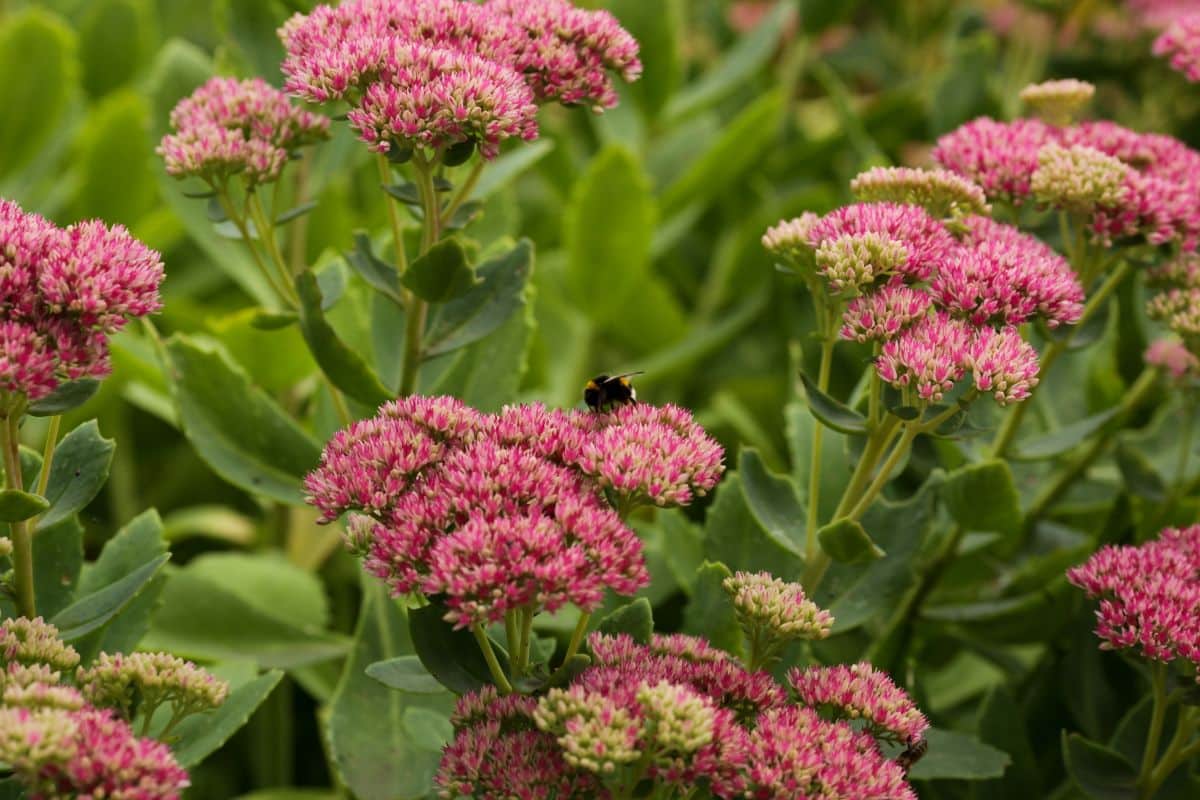
| Plant name: | Sedum |
| Light requirements: | Full sun |
| Watering requirements: | Low |
| Growing zone: | Zones 3 to 11 |
| Special features: | Drought tolerant; Late season blooms; Rock garden favorite |
Also known as stonecrop, sedum is another hardy plant that can grow in clay. While sedum is usually found in sandy soils, it can tolerate different soil types as long as it doesn’t get too wet. Sedum is, after all, a succulent, and it doesn’t need a lot of water!
Drought-tolerant and hardy in cold regions, sedum can grow in zones 3 to 9, and it thrives in full sun. Commonly used as a border plant, sedum is particularly well-suited for rock gardens where its fleshy and colorful leaves will take center stage. Sedum also produces bright blooms in autumn, which provide food for late-season pollinators and can add visual interest to winter gardens too.
18. Helenium (Helenium autumnale)
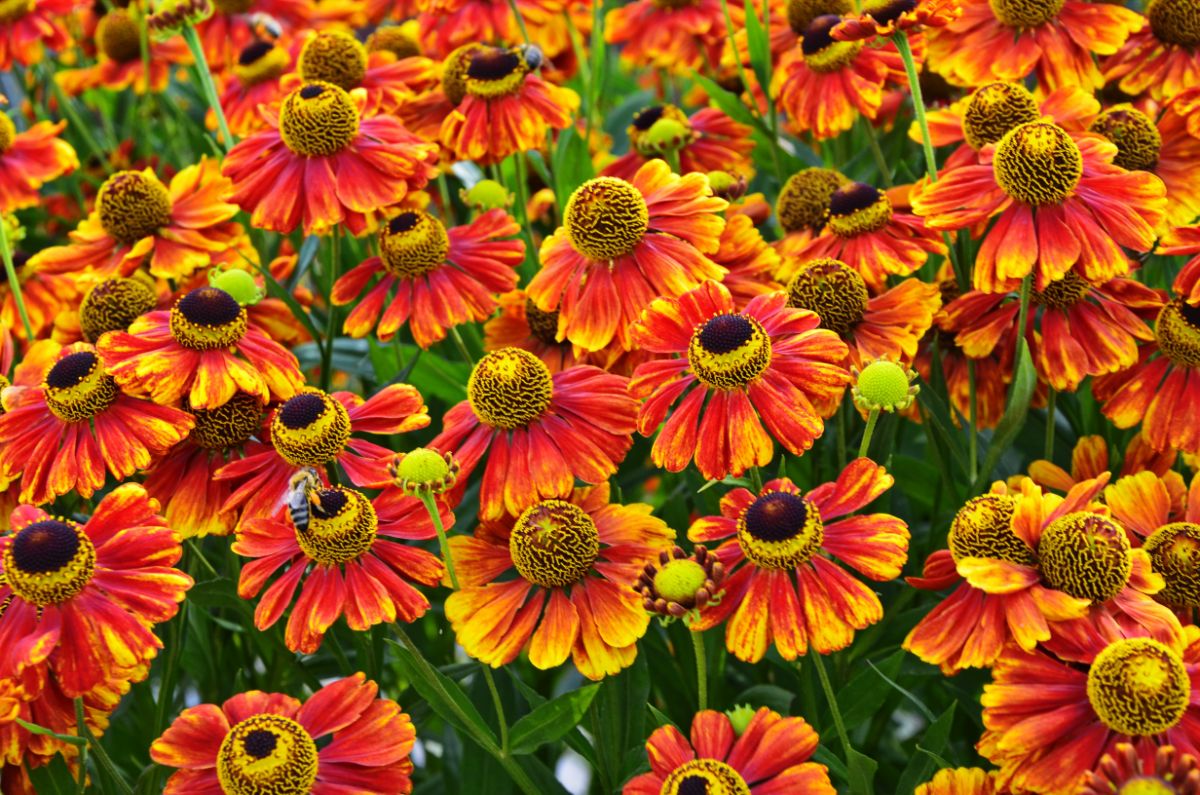
| Plant name: | Helenium |
| Light requirements: | Full sun |
| Watering requirements: | Moderate |
| Growing zone: | Zones 3 to 8 |
| Special features: | Late season blooms |
Also known as sneezeweed, helenium is a sweet plant known for its vivid flowers with scalloped petals encircling a button-shaped center. Flowers come in oranges, reds, and yellows and are highly attractive to butterflies and other insects. A late-season bloomer, helenium can keep the color going in your garden long after other flowers fade.
Hardy to zone 3, helenium is a sturdy plant that can tolerate different soil types. It is also naturally resistant to deer, which makes it a good solution for any garden where deer activity is high. Growing between 3 and 5’ tall, helenium looks lovely in mid-garden plantings, and it pairs beautifully with sedum, goldenrod, and other fall favorites.
19. Viburnum (Viburnum spp.)
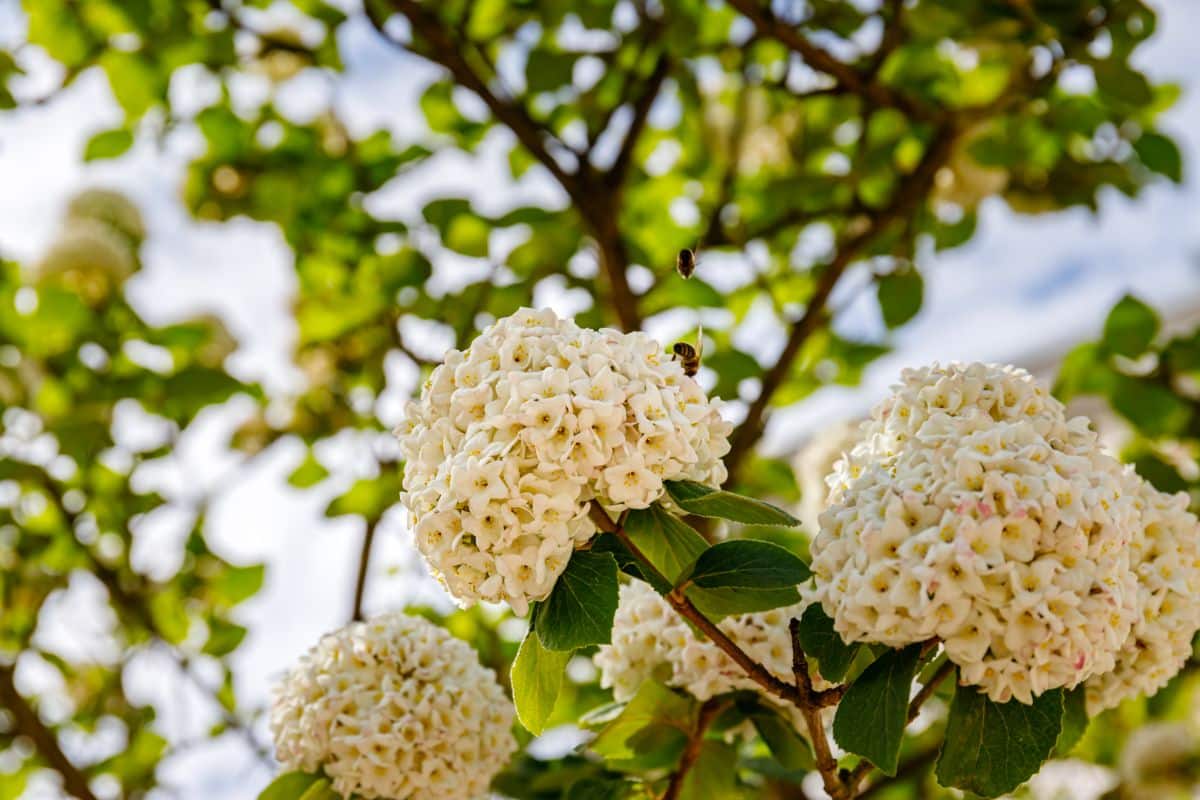
| Plant name: | Viburnum |
| Light requirements: | Full sun to part shade |
| Watering requirements: | Moderate to low |
| Growing zone: | Zones 4 to 8 |
| Special features: | Privacy shrub |
There are between 150 and 175 species of viburnum, including the ever-popular snowball bush viburnum. Many of these species produce showy, globular blooms in pink and white, as well as a flush of colorful berries after the flowers fade. Growing about 10’ tall by 12’ wide, viburnums can be massive plants, but they adjust to pruning easily if you prefer to keep them smaller.
Adaptable and resilient, viburnums can grow in clay soil, as well as part shade or full sun. Bloom time occurs throughout spring and will draw pollinators and birds to your garden. These plants are also generally resistant to deer, although they are occasionally plagued by the viburnum leaf beetle.
20. Cardinal flower (Lobelia cardinalis)
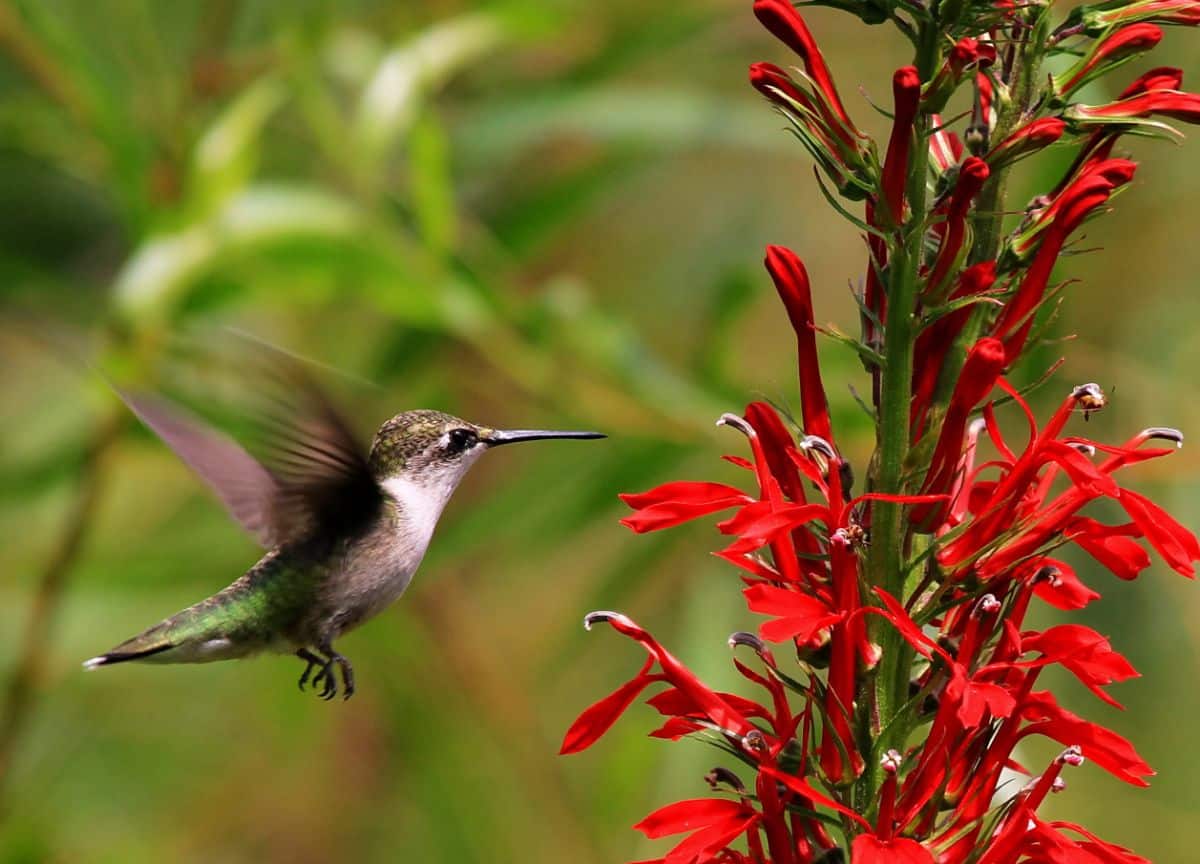
| Plant name: | Cardinal flower |
| Light requirements: | Full sun to part shade |
| Watering requirements: | High |
| Growing zone: | Zones 3 to 9 |
| Special features: | Pollinator favorite; Top pick for rain gardens |
You can’t miss cardinal flowers in the garden! These showy plants produce bright red flowers that hummingbirds can’t resist, but other pollinators and beneficial insects love them too. Cardinal flowers can be tricky to keep since they have high water needs, but if you have clay-heavy soil, they can be a great choice!
Native to the Americas, cardinal flowers naturally grow along streambanks and in other moist areas, and they can be a perfect pick for a rain garden or other water features. These plants can even tolerate occasional flooding, but they should never be allowed to dry out. Adding a thick layer of mulch around the base of your plants can cut down on your plant’s maintenance needs.
21. Goldenrod (Solidago canadensis)
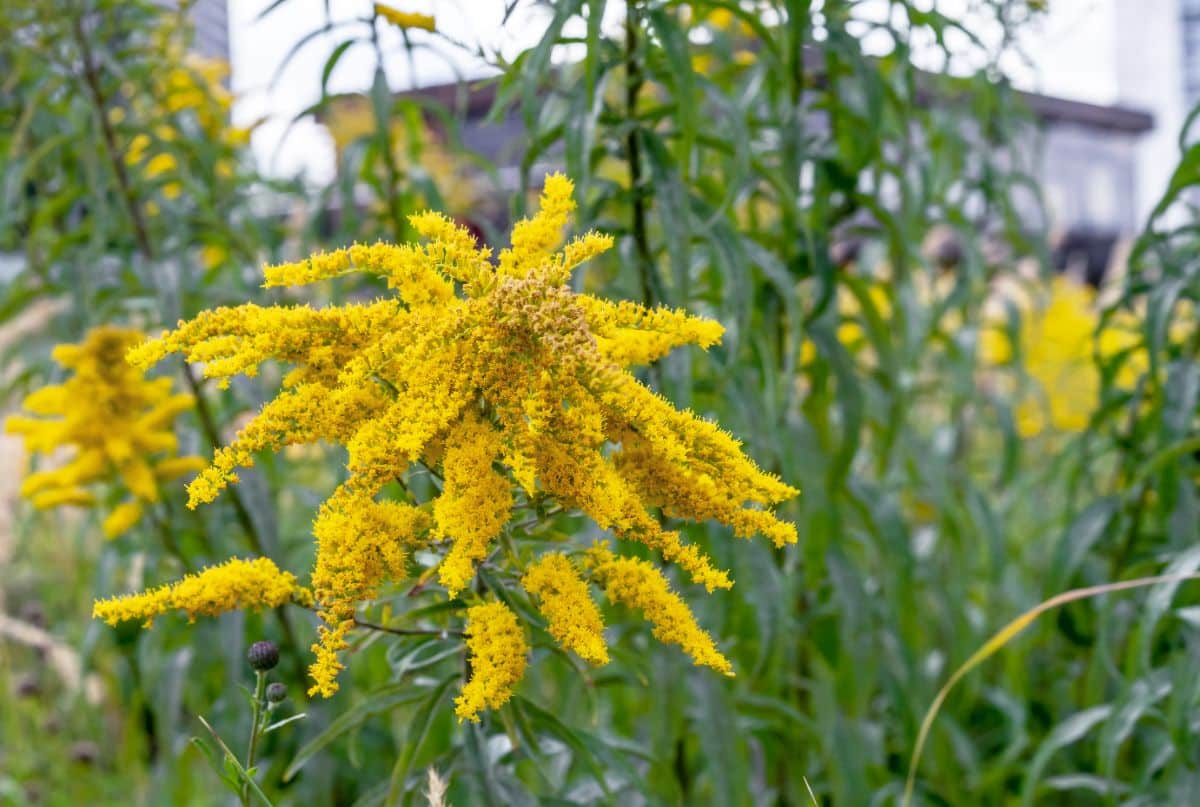
| Plant name: | Goldenrod |
| Light requirements: | Full sun |
| Watering requirements: | Moderate to low |
| Growing zone: | Zones 2 to 8 |
| Special features: | Pollinator favorite; Late season blooms; Drought tolerant |
Some gardeners are reluctant to plant goldenrod as they assume this plant is responsible for seasonal allergies. However, it is actually the similar-looking ragweed that causes itchy eyes and sniffles! Goldenrod, on the other hand, is a charming autumn bloomer that is a must-have in pollinator gardens.
Like asters, goldenrod blooms reliably well in autumn, and these two plants are often paired together in garden designs as they have similar growing needs. Goldenrod can handle a range of garden soils, including clay, and it needs very little water once established. For even more excitement, crafters will delight in the vivid yellow dye that can be brewed from goldenrod for textile projects.
Summary
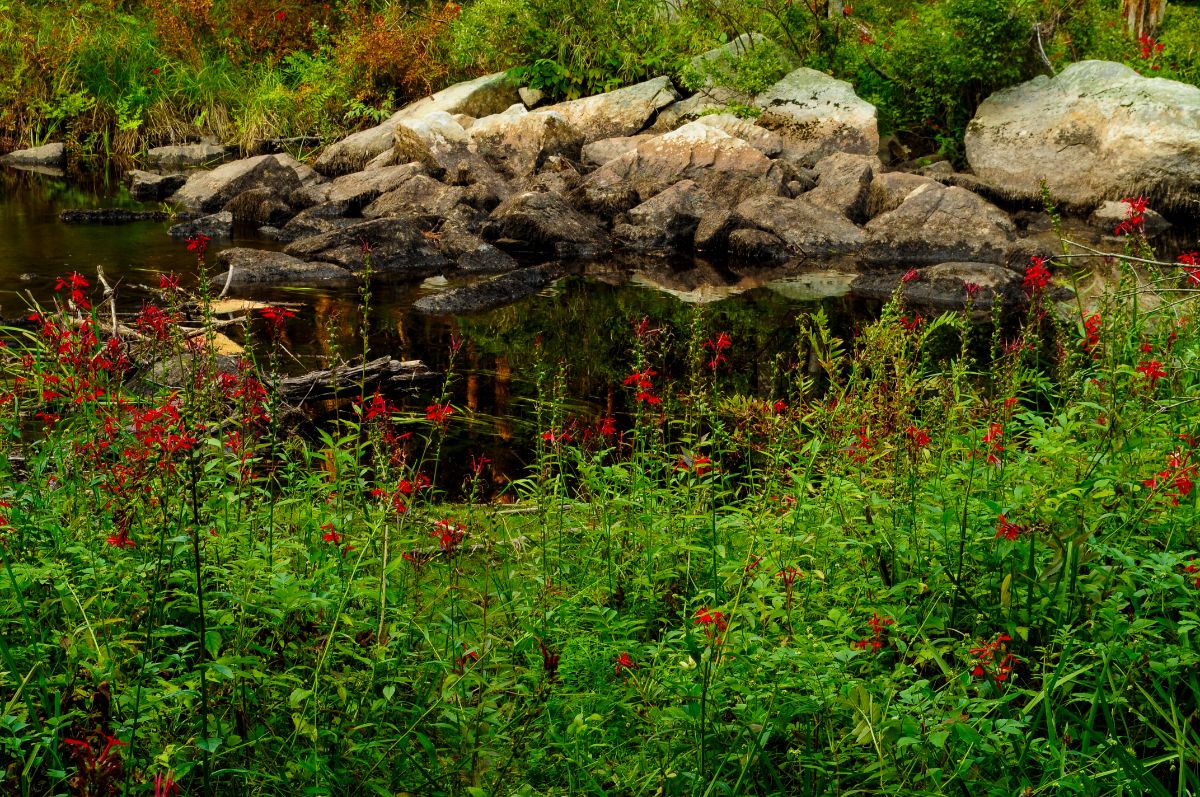
Choosing plants that are adapted to the particular growing conditions of your yard is the best way to simplify your gardening tasks and grow a healthier garden. If you know that your garden is heavy in clay, it may reduce the number of plants you can grow, but by no means is it impossible to garden in clay!
The plants we’ve covered today are all well-suited to clay gardens, and they are hardy enough to grow when other plants can’t. Improving your soil with a bit of organic matter before planting will improve the look of your garden even more, and your new plants will thank you for it.
If you’d like to learn how to create your own compost for improving clay soil, check out our guide on home composting here.

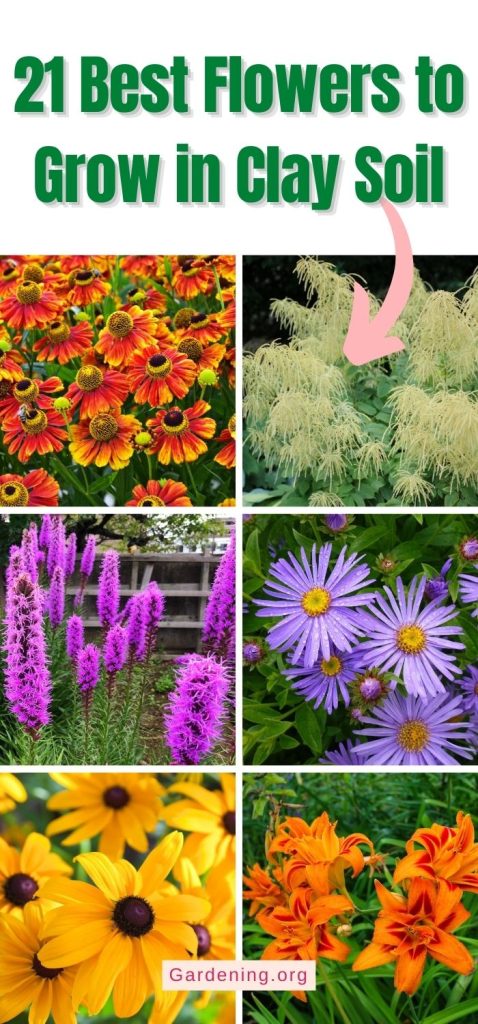
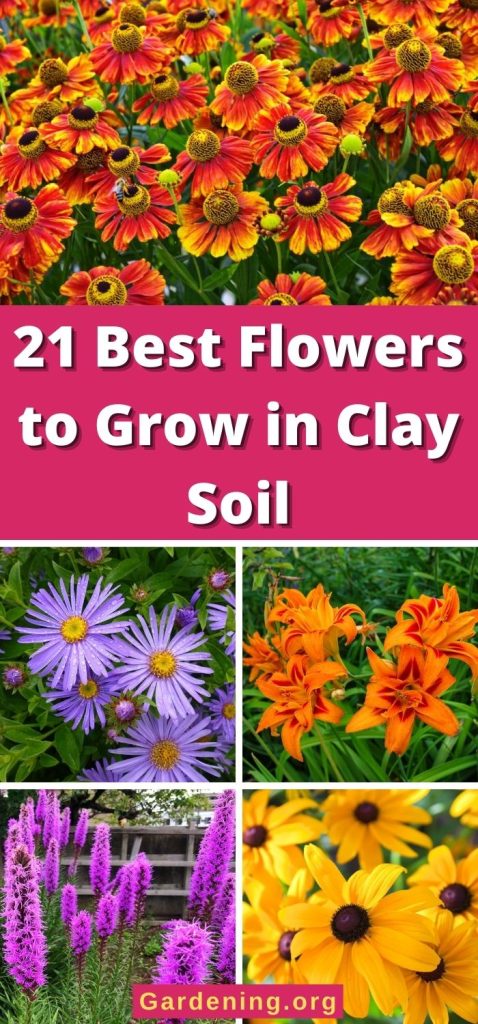
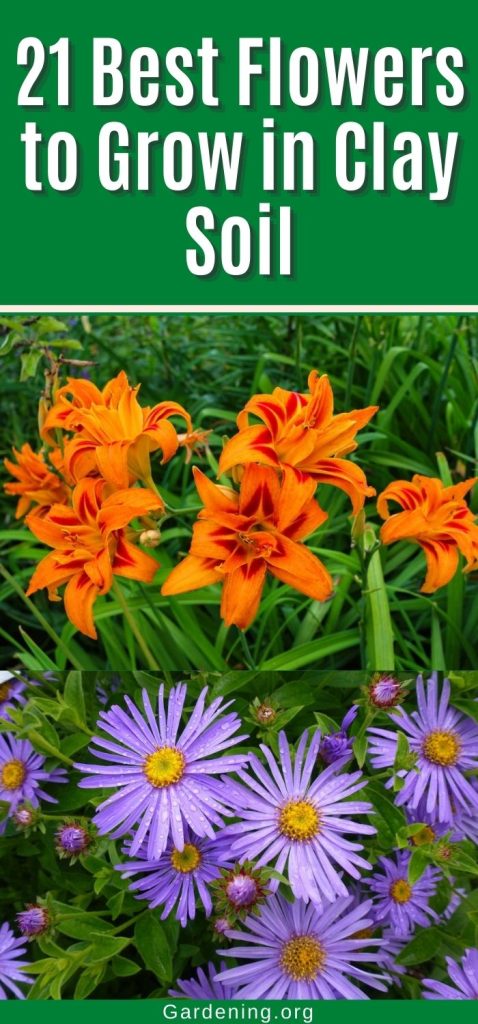
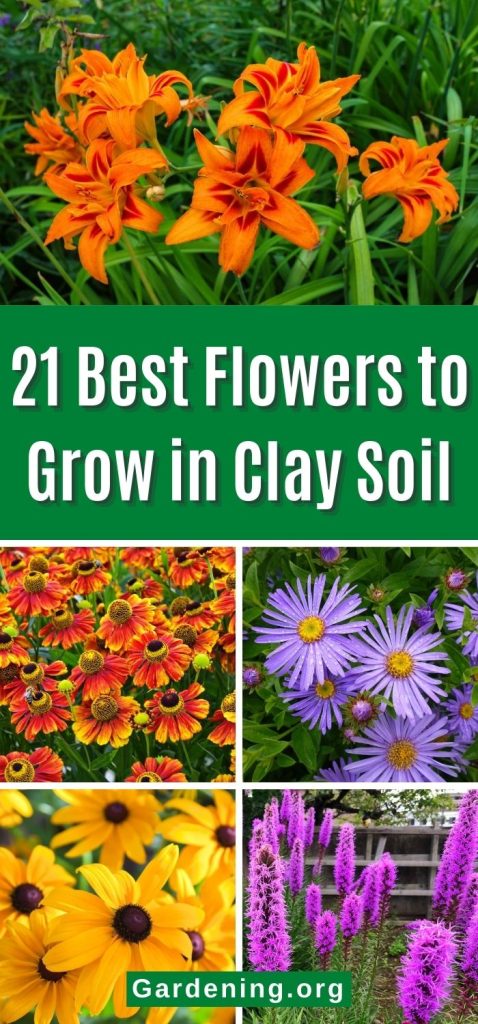

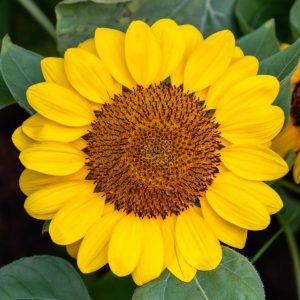
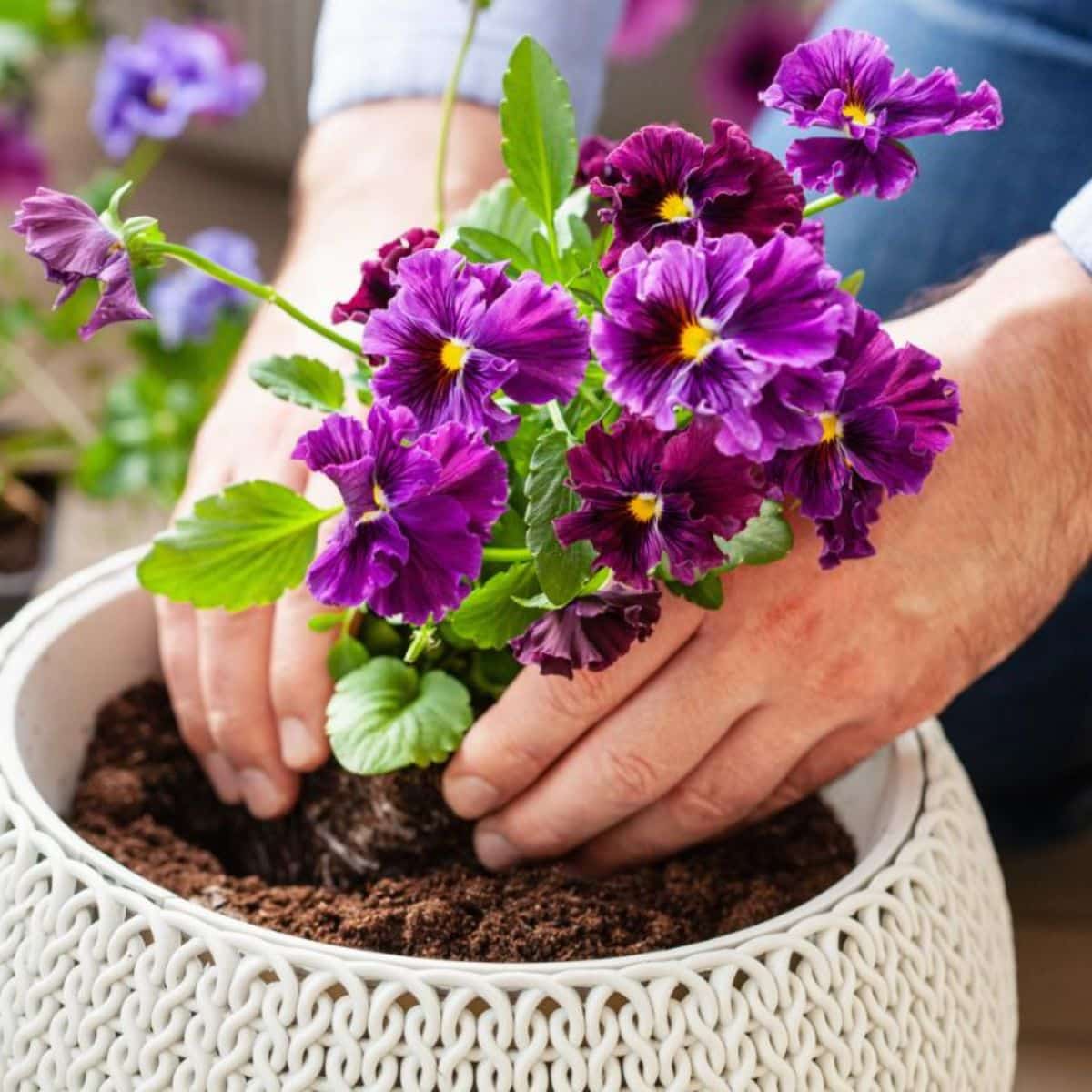
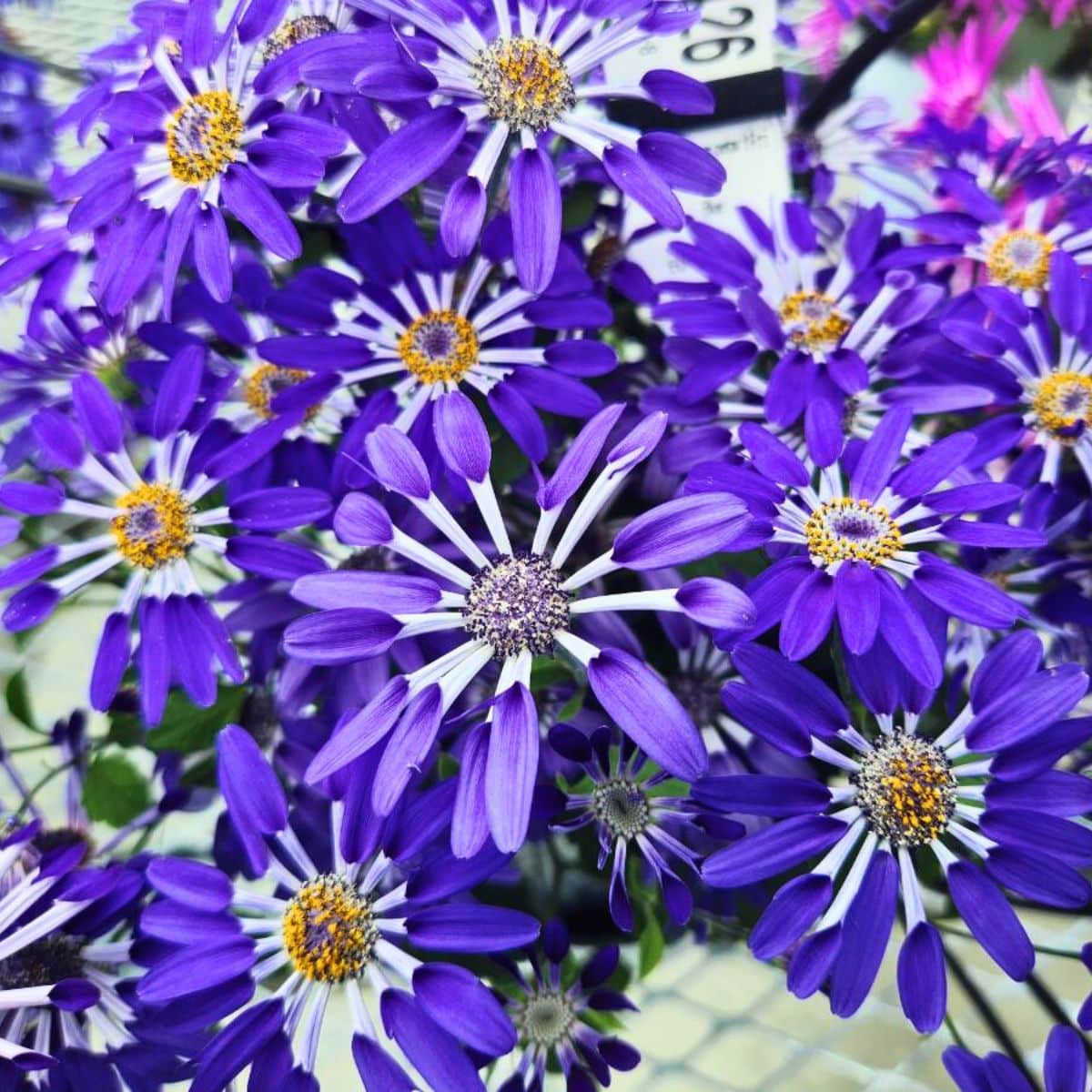
Leave a Reply